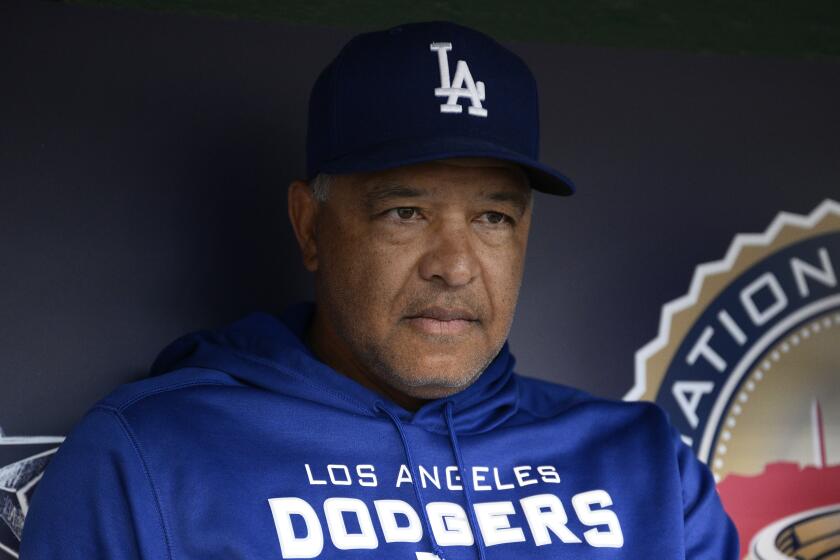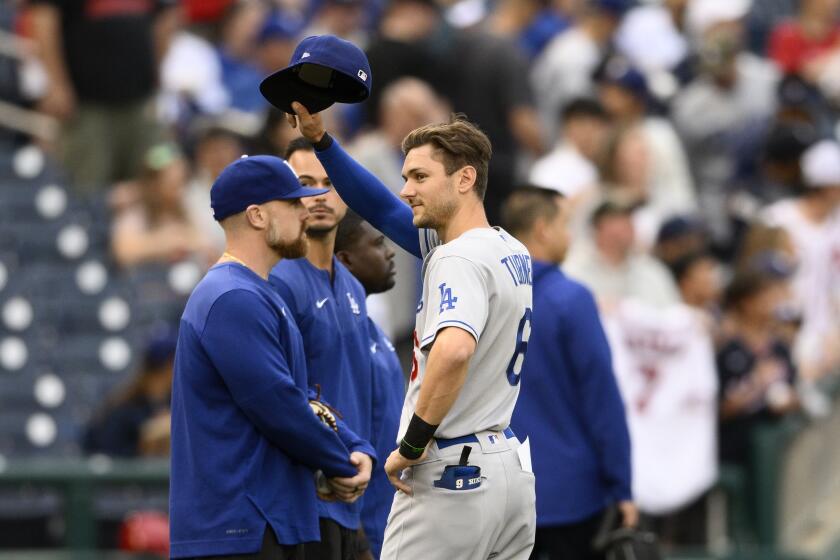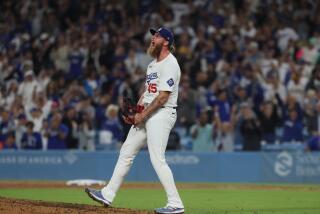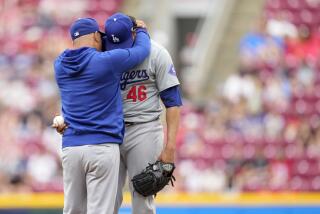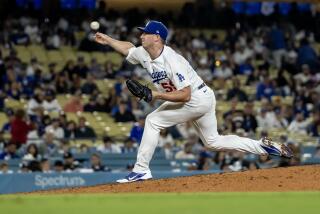The Craig Kimbrel experience: How the Dodgers closer flips the switch from fun to fierce
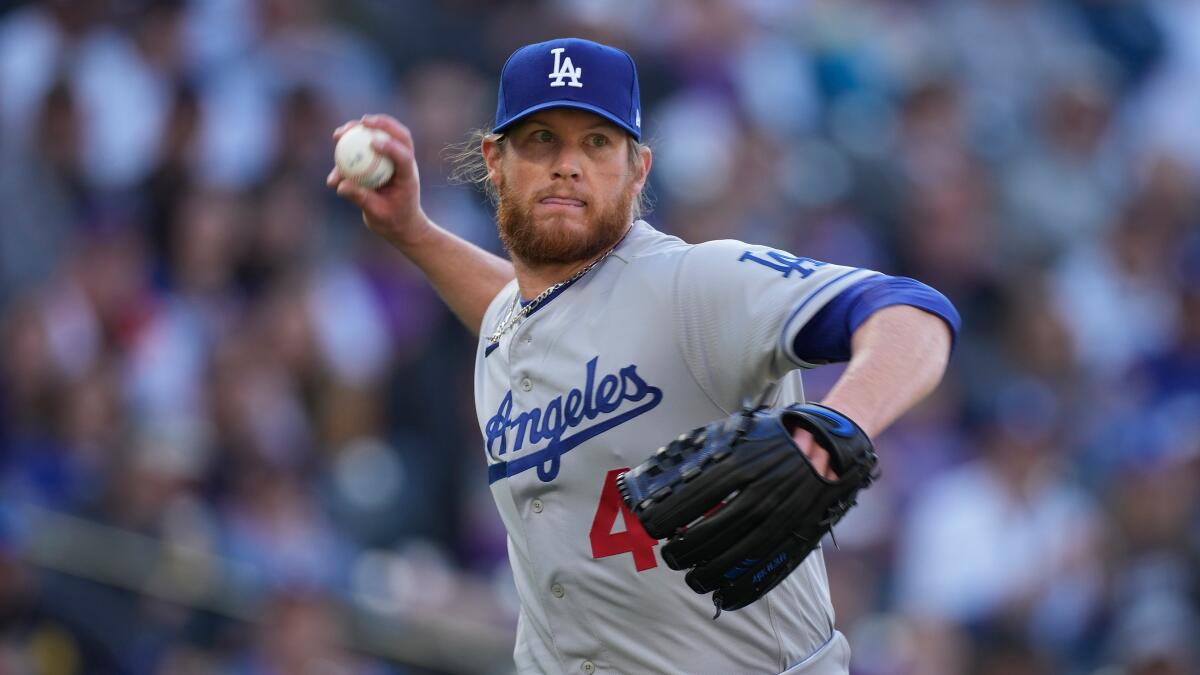
It begins with the first chords of “Sweet Child O’ Mine” by Guns N’ Roses, Slash’s opening guitar riff echoing around Dodger Stadium.
The crowd starts to buzz. The bullpen door swings open. And out lumbers the man with the scruffy beard, curly-haired ponytail and 381 career saves — his unflinching demeanor as stoic as it is imposing as he trots across the field and climbs atop the mound.
It’s all part of the Craig Kimbrel experience. And for the first time this season, Dodgers fans have seen it up close.
Traded to the team before the season, in hopes he could fill a Kenley Jansen-sized hole at the back of the bullpen, Kimbrel’s addition thus far has been a success.
He has converted all nine of his save opportunities, despite a couple of close calls. He has a 4.15 ERA and 17 strikeouts in 13 innings, flashing an overpowering arsenal that has made him the sport’s active career saves leader and all-time leader in strikeout percentage.
Dodgers manager Dave Roberts spent nearly 10 minutes before Wednesday’s game against the Washington Nationals talking to reporters about the Texas shooting.
And he has given ninth innings at Dodger Stadium a new flair, his presence on the rubber — from his foreboding pre-pitch glare to trademark hanging-arm stance — intimidating as ever in his 13th MLB season.
“It’s not one of those closers who comes in the ninth inning and you feel comfortable,” teammate Freddie Freeman said.
“He’s got this look in his eyes,” said fellow reliever Alex Vesia, “you don’t want to mess with that dude when he’s on the mound.”
Two months into his Dodgers tenure, Kimbrel has brought a new dynamic to the clubhouse, too.
Only, in a way that’s completely unlike his on-field presence.
Behind the scenes, the other Craig Kimbrel emerges — the laid-back, upbeat, always-welcoming (and anything but intimidating) nice guy who has become an instant favorite with his new team.
“He’s got his [arm] thing, he’s got a big beard, he’s got a ponytail and he throws 100 — you’d think he’s pretty intense,” Freeman said. “He is on the mound. But when you get him off the mound, he’s just a great guy.”
This side of Kimbrel challenges teammates in video games and golf; is jokingly referred to as the club’s best batting practice shagger by manager Dave Roberts; is a mentor to younger relievers; and is also one of the bullpen’s most relaxed presences for all but one inning every night.
During a game this season, Kimbrel and David Price were laughing and cracking jokes right up until the middle of the eighth. Then Kimbrel tied his shoes, threw some warm-up pitches and blew away three Atlanta Braves hitters in order for a stress-free save.
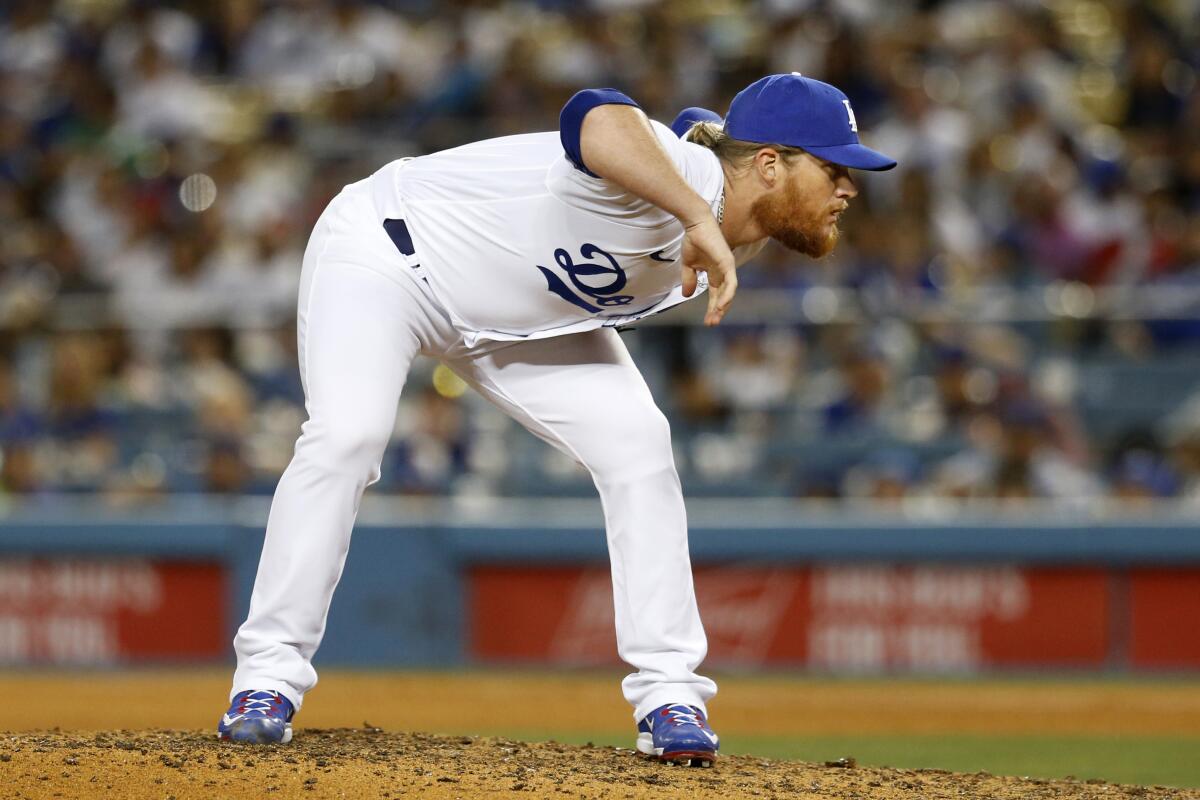
“He flips that switch and turns into the Hall of Famer that he is when he takes the mound,” Price said. “It takes a special person to be able to do that.”
After another outing in San Diego, Kimbrel mentioned to Freeman his neck had felt tight during the game, only to spin it as a positive that forced him to focus on his mechanics.
“I’m like, ‘Only you would think that,’ ” Freeman said with a laugh, recalling the conversation.
And last week, when the team’s bus in Philadelphia blew a tire on the way to Citizens Bank Park, Roberts sarcastically asked if anyone could put on the spare.
Kimbrel’s hand shot in the air.
“It’s hard to even talk about the closer Craig,” Freeman said. “Because the person Craig is so much better.”
Standing next to the Dodgers dugout recently, Kimbrel smirked when asked about his dueling reputations — about the opposite personas that he so seamlessly toggles between, that he has balanced to perfection.
“There’s definitely a switch there,” Kimbrel said. “A lot of people ask me, why do I do what I do on the mound. I think that has a lot to do with it. It’s a good separator between who I am, and who I’m trying to be out there.”
He laughed.
“I guess it feels good to hear that everybody sees me as a fun guy, and a laid-back guy,” he said. “Because it’s kind of how I try to be.”
===
Kimbrel never planned to make his mark at the end of games.
Growing up, he dreamed of being in a big league rotation. Even now, he jokingly refers to himself as a “failed starter.”
“I think we all think about being on the mound in the last inning,” he said. “But most of the time, as a kid, we started that game as well.”
Born and raised in Huntsville, Ala., Kimbrel’s prospects for any sort of professional career blossomed late — and somewhat by accident.
Trea Turner was taken by surprise when the Dodgers acquired him last July, but in his first return to Washington, D.C., he is pleased with his new home.
In high school, the right-hander’s fastball rarely surpassed low-90s mph. But after breaking his foot following graduation, the recovery process changed his career. He put on 30 pounds, built strength in his upper body and practiced throwing from his knees while his foot healed.
“When I came back,” he said, “I was throwing harder.”
Much, much harder.
At Wallace State, a junior college near his home, Kimbrel started reaching the upper 90s. He was drafted by the Atlanta Braves in the 33rd round following his freshman season, then again in the third round a year later after returning to school for an impressive sophomore campaign in 2007.
He didn’t shoot straight to the majors, getting demoted from the Braves’ high A to low-A affiliate amid struggles during his second pro season in 2009. But by the end of that year, he’d mastered a fastball-curveball combination that put him on the fast track to an MLB debut the next season.
“Once he got sent down,” said Freeman, another Braves prospect who was also on the Braves high-A team at the time, “he turned into who he is now.”
In his early days with the Braves, however, Kimbrel was almost timid as he adjusted to life in the majors.
Then-Braves bullpen coach Eddie Pérez, who is still part of the team’s major league staff, used to pretend to get mad at the young pitcher just to see how he’d react. One day, Pérez remembers Kimbrel being unsure if he was even allowed to wave to his dad from the bullpen.
“He was so shy the first time he came up,” Pérez said recently with a laugh. “He would worry about a lot of things.”
Kimbrel’s dominant stuff, however, made him a success. He won the rookie-of-the-year award in 2011, and led the National League in saves each of his first four full seasons.
His ninth-inning persona — including the raised-arm stance, which began as a way to manage bicep tendinitis during his rookie season and has become a staple of his routine ever since — crystalized, as well.
“I think that adrenaline and the expectation for what’s expected in that role, I think helped me out, especially younger in my career,” Kimbrel said. “I had to be responsible for myself and all my teammates. I viewed it like that.”
That didn’t change even as Kimbrel’s surroundings did.
On the eve of the 2015 season, he was dealt to the San Diego Padres, where Roberts was the club’s bench coach.
“You assume as a closer, he has a certain kind of demeanor on the mound,” Roberts said. “But when you get to know him, it’s a different personality when he gets between the lines. And that’s kind of the way you want it.”
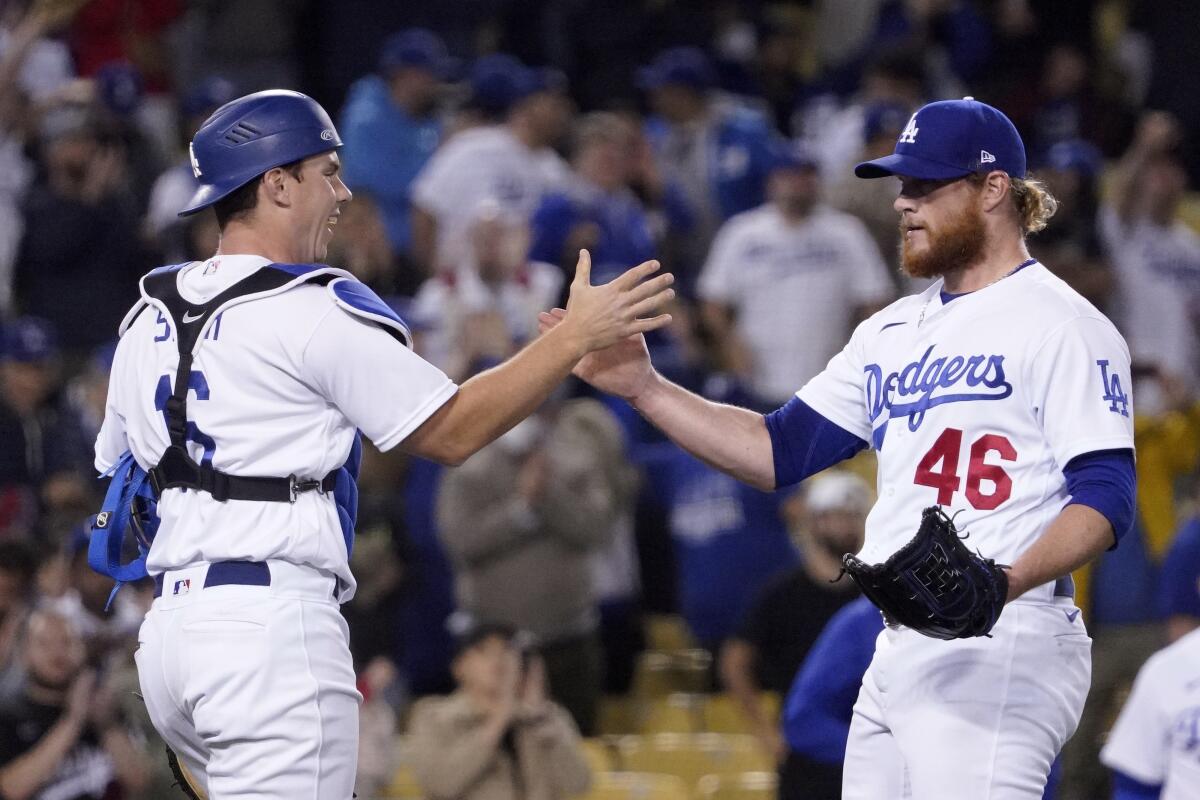
Kimbrel was on the move again the next winter, dealt to the Boston Red Sox in another blockbuster deal.
“He was the same as he is now,” said Price, a starter on those Red Sox teams. “Really genuine, a lot of fun to be around.”
When Kimbrel’s free agency in 2019 dragged on three months into the season, Freeman tried wooing him back to Atlanta before he ultimately signed with the Chicago Cubs.
“He’s kind of been all over the map the last few years going team to team,” Freeman said. “But that’s who he is. Everybody wants Craig Kimbrel. He’s been doing it for a long time.”
===
Freeman and Kimbrel were reunited after all, this spring.
Though Kimbrel had three up-and-down seasons in Chicago — he posted career-worst ERAs in 2019 and 2020 with the Cubs, bounced back with a strong All-Star worthy first half of 2021, then slumped again following a trade to the White Sox at the deadline — the Dodgers targeted him after Jansen signed with the Braves.
A couple of weeks after Freeman signed with the Dodgers, a trade for Kimbrel finally materialized too, with the club shipping AJ Pollock to the White Sox.
“It’s kind of weird how baseball works sometimes,” Freeman said. “My wife got a picture of him pitching and me playing first. Who would have thought eight years later, we’re teammates again.”
Price, Roberts and others who have crossed paths with Kimbrel before shared similar reactions, happy to be back in the presence of the eight-time All-Star .
“I just love the way that, it’s like every day is his first day in the big leagues,” Roberts said. “Which is pretty cool to see, a guy that’s so accomplished, and not jaded.”
For the rest of the Dodgers, however, it has been their first time seeing the veteran up close.
They knew about his mound presence. They’ve been equally impressed by everything Kimbrel, who turned 34 on Saturday, brings behind the scenes.
“He loves to talk and interact with the guys, and treats me like I’m a brother,” Vesia said. “It’s cool when he comes to me and is like, ‘Good job, you were nasty tonight.’ ”
Added Daniel Hudson, the other veteran reliever the Dodgers added this offseason: “He’s definitely a guy you lean into, just because he’s been so consistent and successful throughout his career.”
It has all been on display over the first couple months this season.
Though save situations have surprisingly been few and far between for the first-place club — Kimbrel has gone through two separate 13-day stretches in which he didn’t face a save opportunity — he has converted each one, executing a straightforward approach that underlines his solemn in-game demeanor.
“Honestly, I want to be as boring as possible,” he said. “Strikeouts are fun and they look great. But a quick 1-2-3 inning and send everybody home happy, that’s really what I see my job as. Solidifying what everybody’s done throughout the game.”
After one save this month, when Kimbrel stranded two runners in a win against the San Francisco Giants, Vesia noticed the closer kept the ball.
When the third-year pitcher asked him why, Kimbrel — back in his nonchalant, off-the-mound mindset — tried not to make it sound like a big deal.
He’d just tied Joe Nathan for the eighth most saves in MLB history.
“It just put it all in perspective,” Vesia said with a chuckle. “With this guy, we’re literally witnessing history.”
More to Read
Are you a true-blue fan?
Get our Dodgers Dugout newsletter for insights, news and much more.
You may occasionally receive promotional content from the Los Angeles Times.

